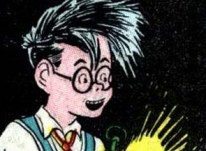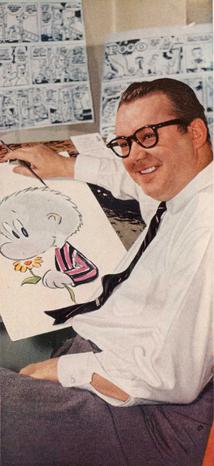
Walter Crawford Kelly Jr., commonly known as Walt Kelly, was an American animator and cartoonist, best known for the comic strip Pogo. He began his animation career in 1936 at Walt Disney Studios, contributing to Pinocchio, Fantasia, and Dumbo. In 1941, at the age of 28, Kelly transferred to work at Dell Comics, where he created Pogo, which eventually became his platform for political and philosophical commentary.

Mutt and Jeff was a long-running and widely popular American newspaper comic strip created by cartoonist Bud Fisher in 1907 about "two mismatched tinhorns". It is commonly regarded as the first daily comic strip. The concept of a newspaper strip featuring recurring characters in multiple panels on a six-day-a-week schedule had previously been pioneered through the short-lived A. Piker Clerk by Clare Briggs, but it was Mutt and Jeff as the first successful daily comic strip that staked out the direction of the future trend.

All-American Comics is a comics anthology and the flagship title of comic book publisher All-American Publications, one of the forerunners of DC Comics. It ran for 102 issues from 1939 to 1948. Characters created for the title, including Green Lantern, the Atom, the Red Tornado, Doctor Mid-Nite, and Sargon the Sorcerer, later became mainstays of the DC Comics line.

Red Tornado is a fictional character appearing in American comic books published by DC Comics. As the second character to assume the identity of Red Tornado, he is the result of an android being merged with a sentient tornado by T.O. Morrow.

An American comic book is a thin periodical originating in the United States, on average 32 pages, containing comics. While the form originated in 1933, American comic books first gained popularity after the 1938 publication of Action Comics, which included the debut of the superhero Superman. This was followed by a superhero boom that lasted until the end of World War II. After the war, while superheroes were marginalized, the comic book industry rapidly expanded and genres such as horror, crime, science fiction and romance became popular. The 1950s saw a gradual decline, due to a shift away from print media in the wake of television and the impact of the Comics Code Authority. The late 1950s and the 1960s saw a superhero revival and superheroes remained the dominant character archetype throughout the late 20th century into the 21st century.
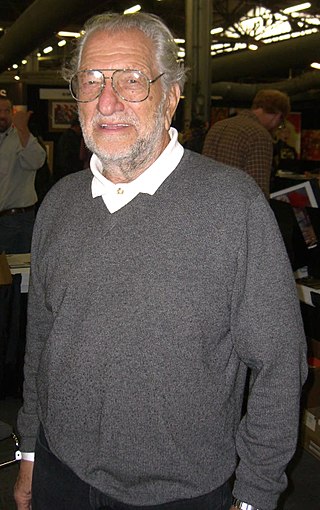
Joseph Kubert was a Polish-born American comic book artist, art teacher, and founder of The Kubert School. He is best known for his work on the DC Comics characters Sgt. Rock and Hawkman. He is also known for working on his own creations, such as Tor, Son of Sinbad, and the Viking Prince, and, with writer Robin Moore, the comic strip Tales of the Green Beret.

Paul Levitz is an American comic book writer, editor and executive. The president of DC Comics from 2002 to 2009, he worked for the company for over 35 years in a wide variety of roles. Along with publisher Jenette Kahn and managing editor Dick Giordano, Levitz was responsible for hiring such writers as Marv Wolfman and Alan Moore, artists such as George Pérez, Keith Giffen, and John Byrne, and editor Karen Berger, who contributed to the 1980s revitalization of the company's line of comic book heroes.

Hoppy the Marvel Bunny is a fictional character appearing in American comic books originally published by Fawcett Comics and later DC Comics as a spin-off of Captain Marvel. He was created by Chad Grothkopf (1914–2005), and debuted in Fawcett's Funny Animals #1. A comic book superhero and an anthropomorphic animal, Hoppy has made periodic appearances in stories related to Captain Marvel, today also known as Shazam or The Captain.
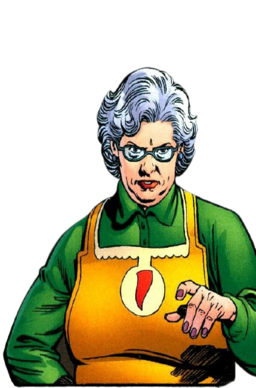
Abigail Mathilda "Ma" Hunkel is a fictional character appearing in American comic books published by DC Comics. Debuting during the Golden Age of Comic Books, she first appeared in her civilian identity in All-American Publications' All-American Comics #3, created by Sheldon Mayer, and became the first character to be known as the Red Tornado in All-American Comics #20. As the Red Tornado, she was one of the first superhero parodies, as well as one of the first female superheroes and the first cross-dressing heroine, debuting months after Madame Fatal, the first cross-dressing male hero.
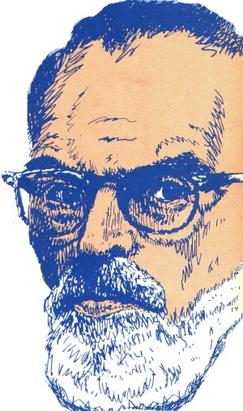
Sheldon Mayer was an American comics artist, writer, and editor. One of the earliest employees of Major Malcolm Wheeler-Nicholson's National Allied Publications, Mayer produced almost all of his comics work for the company that would become known as DC Comics.

Thomas P. Gill was an American comic book artist best known for his nearly 11-year run drawing Dell Comics' The Lone Ranger.
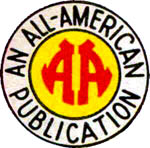
All-American Publications, Inc. was one of two American comic book companies that merged to form the modern-day DC Comics, one of the two largest publishers of comic books in the United States. Superheroes created for All-American include the original Atom, Flash, Green Lantern, Hawkman, and Wonder Woman, all in the 1940s' Golden Age of Comic Books.
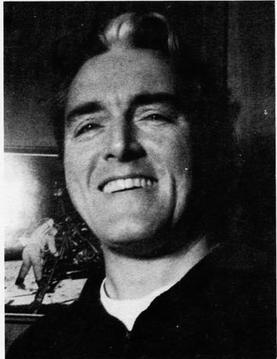
Frank Springer was an American comics artist best known for Marvel Comics' Dazzler and Nick Fury, Agent of S.H.I.E.L.D.. As well, in collaboration with writer Michael O'Donoghue, Springer created one of the first adult-oriented comics features on American newsstands: "The Adventures of Phoebe Zeit-Geist" in the magazine Evergreen Review. A multiple winner of the National Cartoonists Society's Reuben Award, Springer was a president of the Society and a founding member of the Berndt Toast Gang, its Long Island chapter.

Reg'lar Fellers is a long-running newspaper comic strip adapted into a feature film, a radio series on the NBC Red Network, and two animated cartoons. Created by Gene Byrnes (1889–1974), the comic strip offered a humorous look at a gang of suburban children. Syndicated from 1917 to January 18, 1949, Byrnes' strip was collected into several books. Branding also extended to such items as baseball bats and breakfast cereal.

Cyclone is a superheroine appearing in American comic books published by DC Comics. She is the granddaughter of the original Red Tornado, the niece of the Cyclone Kids, and a member of the Justice Society of America.
Black people have been portrayed in comics since the medium's beginning, with their portrayals often the subject of controversy. Mainstream comic publishing companies have had a historical trend of being predominantly white and male, reflecting the lack of representation and inaccurate depictions of Black people in comics. The integration of black characters in mainstream and superhero comics has endured various obstacles and challenges. Critics have noted that black men and women have historically often been portrayed as jungle or ghetto stereotypes, and as sidekicks as opposed to primary characters. Occiasionally, comic book creators would lampshade stereotypes, lack of representation and emphasize social injustices. In recent years, with the integration of more Black people in mainstream comic writing rooms as well as the creation of comics on digital platforms has changed the representation and portrayals of Black people in comics and has started to reflect the complexities of Black people across the diaspora.
Comics has developed specialized terminology. Several attempts have been made to formalize and define the terminology of comics by authors such as Will Eisner, Scott McCloud, R. C. Harvey and Dylan Horrocks. Much of the terminology in English is under dispute, so this page will list and describe the most common terms used in comics.
Uncle Art's Funland is a long-running syndicated weekly puzzle and entertainment feature originated by Art Nugent (1891–1975). Featuring jokes, riddles, and paper-and-pencil word games, math challenges, nonograms, connect-the-dots art, crossword puzzles and anagrams, Funland has appeared in newspapers and comic books since 1933, and has been syndicated regularly since 1950.
National Comics Publications and All-American Publications, two precursors to DC Comics, were formed publishing American comic books such as superhero comics starting in the 1930s. Primary Comic book anthology titles created by the company was More Fun Comics, Adventure Comics, Detective Comics, Action Comics, All-American Comics and Superman. Other companies like Quality Comics and Fawcett Comics would later be merged into DC. Quality started by introducing comic books like Feature Comics and Smash Comics.
Red Tornado is a codename for different characters appearing in American comic books published by DC Comics that appear in the mainstream and other realities. The most common of them is Ma Hunkel and the android version.
